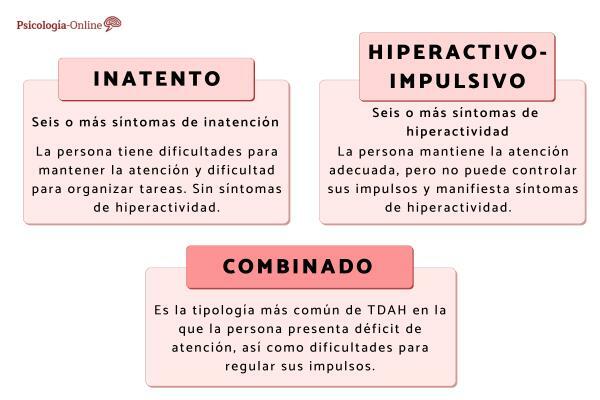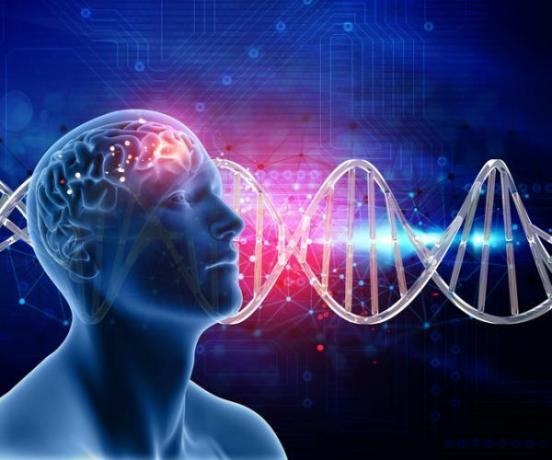
Attention deficit hyperactivity disorder is a very common neurodevelopmental disorder in children and adolescents. It is defined as a biological dysfunction, of cerebral origin, that affects the capacity of the minor, adolescent or adult to pay attention, regulate your motor activity (hyperactivity), and curb your behaviors or thoughts (impulsiveness).
In general, it has important academic, psychological and social repercussions, in addition to affecting their closest environment. This disorder is much more frequent in boys than in girls, because for every 3 or 4 boys who are diagnosed with ADHD, it is a girl. On the other hand, in adults the difference is reduced to the fact that for every 2 men who suffer from ADHD, one woman presents it. So why can two people diagnosed with the same thing be so different? In this Psychology-Online article, we explain the different types of ADHD as stated in the DSM-V and what are its symptoms and causes.
Index
- Inattentive attention deficit disorder (ADD)
- Attention deficit hyperactive and impulsive disorder (ADHD)
- Combined attention deficit hyperactivity disorder
- Causes of attention deficit hyperactivity disorder (ADHD)
Inattentive attention deficit disorder (ADD)
Often, the person suffering from inattentive type ADHD can present the following symptoms, at least 6 of them or 5 for adults over 17 years of age, for at least 6 months:
- Does not pay enough attention to details or makes mistakes by neglecting the tasks they perform, whether they are school, work or in other areas.
- Difficulty sustaining attention in homework or play activities.
- doesn't seem to listen when speaking directly.
- does not follow instructions or does not finish what it starts.
- Difficulty organizing tasks and activities
- Avoids, dislikes, or is averse to tasks that require sustained mental effort.
- misplace objects needed for certain tasks or activities.
- is easily distracted with irrelevant stimuli.
- Is forgetful or careless in activities, chores, and errands.
To determine that it is this type of attention deficit disorder, the symptoms mentioned must be present in more than one area of the person's life. In addition, there must be clear evidence that the symptoms present are interfering with the individual's development and quality of life. If you have doubts, in this article, we will show you how to detect attention deficit in children.
Attention deficit hyperactive and impulsive disorder (ADHD)
Frequently, the person suffering from ADHD of the hyperactive and impulsive type presents the following symptoms, at least 6 of them or 5 for adults over 17 years of age, for at least 6 months:
- Excessive movement of the hands or feet or moves in the seat.
- Is usually restless in situations that require sitting still.
- Excessive running or jumping in inappropriate situations. In adults, subjective feelings of restlessness may be present.
- Is too loud or rowdy during play, leisure or social activities.
- Is uncomfortable if you have to stand still for a long time. Others perceive him as restless and find it difficult to be with such people.
- He talks excessively.
- Hasty answers before they finish asking things. Adults may complete each other's sentences or butt into conversations.
- Has difficulty taking turns or wait in line.
- Interrupt or interfere in other people's business.
When determining whether it is hyperactive and impulsive ADHD, the symptomatology must be present in more than one area of the person's life. It is also necessary to be able to prove that these symptoms are interfering or seriously affecting the affected person.

Combined attention deficit hyperactivity disorder.
In the type of combined attention deficit hyperactivity disorder, 6 or more symptoms of those mentioned above are manifested, both of the symptomatology of the inattentive group as well as that of the hyperactivity group and impulsivity. Moreover, in this case, the symptoms manifest themselves under the same conditions as the previous two types.
If you need more information about it, in these articles, we tell you how the ADHD in adults and the ADHD in children.
Causes of attention deficit hyperactivity disorder (ADHD)
ADHD is considered a disorder with multifactorial etiology, that is, the causes that have been found and related to attention deficit hyperactivity disorder are a combination of both individual and environmental factors that influence the subject. In short, the types of ADHD arise from the interaction of genetic and environmental factors, although genetics has a greater weight by 75%.
individual factors
Individual risk factors for ADHD include the following:
- Genetic factors: dopaminergic, noradrenergic, serotonergic pathways and some proteins involved in the exocytosis of neurotransmitters, from the storage vesicles of neurons to the synaptic cleft.
- perinatal factors coupled with genetic vulnerability, such as low birth weight, maternal alcohol or tobacco use.
- receptors and neurotransmitters: some studies report a dysfunction of the prefrontal cortex and other cortical brain areas and subcortical cells in which the dopaminergic, noradrenergic and serotonergic.
- decreased brain volume total.
- Alterations in the internal capsule, cerebellum and anterior corona radiata.
- Inadequate resting brain activity.
- Difficult temperament.
Environmental factors
Environmental risk factors
- Educational styles and family interaction: if there is a lack of control, rejection and the absence of supervision prevails with a little affectionate relationship, this will generate in the son or daughter lacks affection and poor bonding with parents, low self-control and impulsiveness and little interest school. A style dominated by a lack of control and supervision, with a lack of demand for affection and acceptance, favor immature behavior with little self-control, little independence, little responsibility, and greater aggressiveness.
- Parental psychopathology that generates a insecure attachment.

This article is merely informative, in Psychology-Online we do not have the power to make a diagnosis or recommend a treatment. We invite you to go to a psychologist to treat your particular case.
If you want to read more articles similar to Types of ADHD and their characteristics, we recommend that you enter our category of Clinical psychology.
Bibliography
- sure, a. b. J. (2009). ADHD, Attention Deficit Hyperactivity Disorder, in the current diagnostic classifications (ICD 10, DSM IV-R and CFTMEA-R 2000). Mental Health North, 8(35), 30-40.


